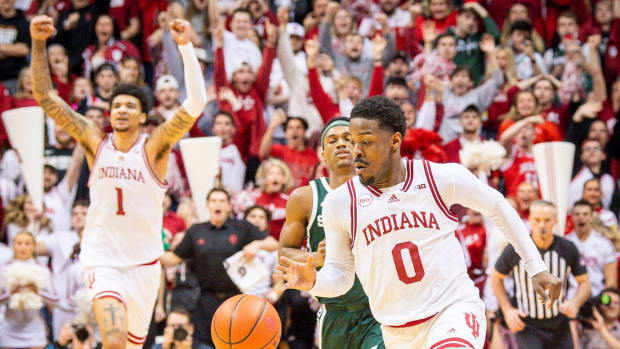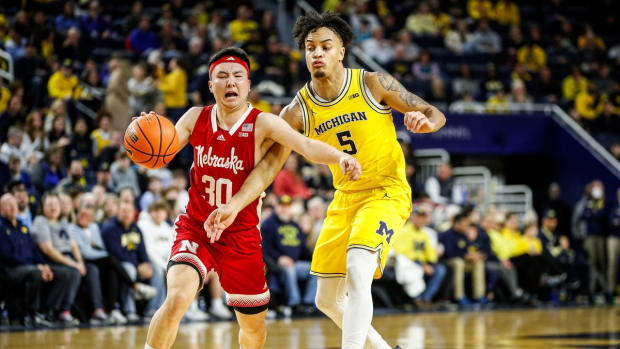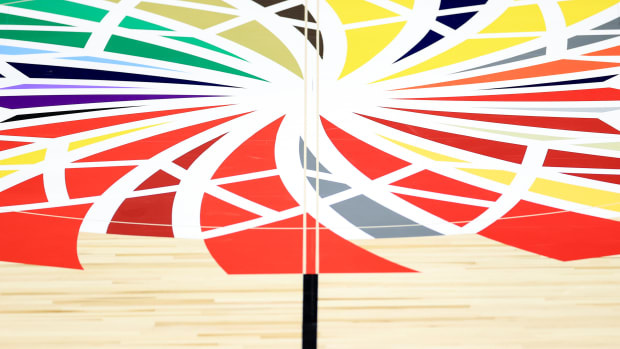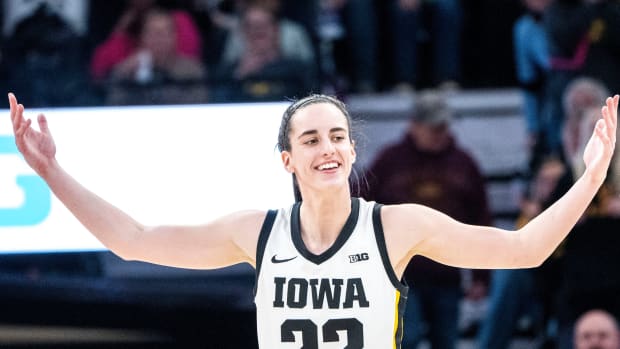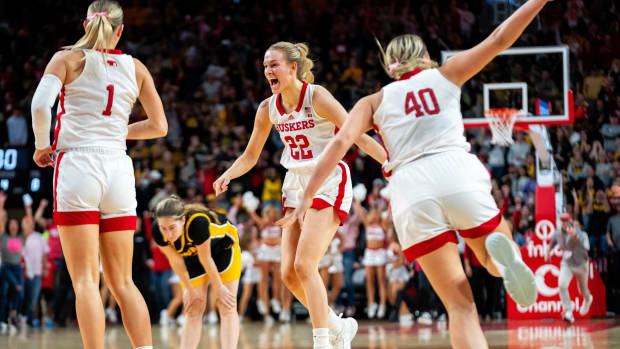Talking Points: Michigan Basketball Pre- & Post-Op Of A Cold Night In Louisville
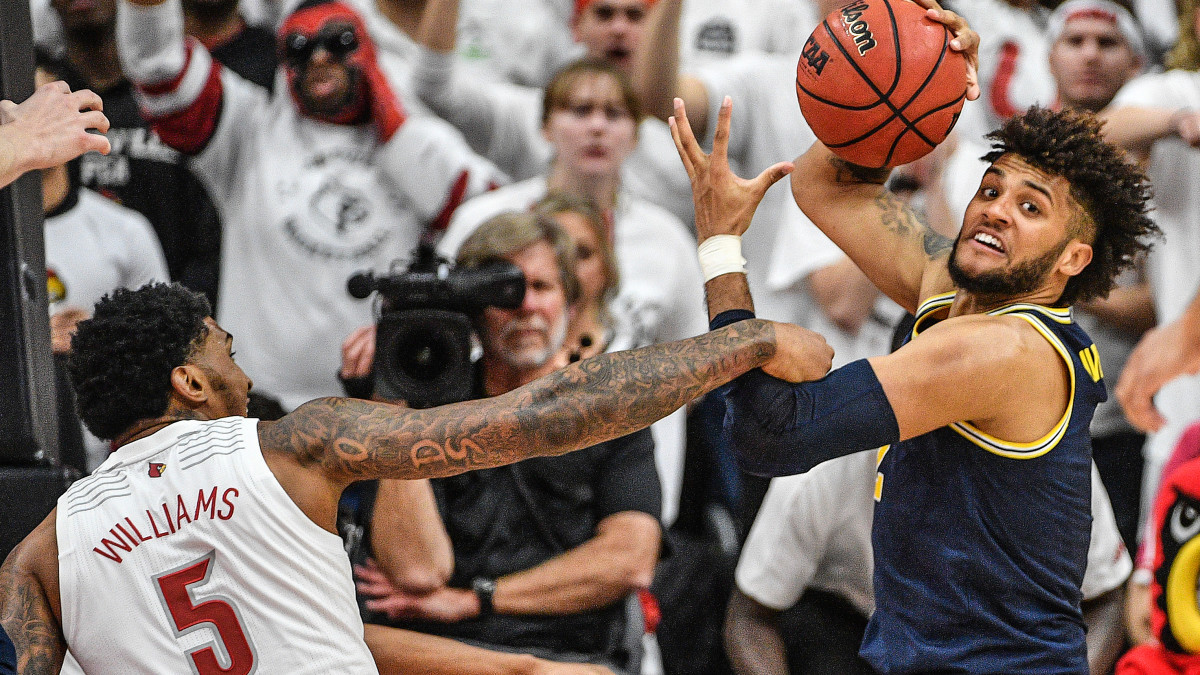
Prior to its matchup against No. 1 Louisville, Michigan head coach Juwan Howard addressed the challenge presented by his team’s first true road test of the season.
“We’re playing in a tough environment, we’re going to the lion’s den, I would say. They play extremely well at home. This is going to be our first time being road tested in non-conference play, I’m looking forward to the challenge and I know our players are too.”
The Wolverines were up to the challenge defensively, holding the top team in the country to just 58 points. Offensively, however, they bore little resemblance to the team that mauled two top-10 opponents less than a week ago.
U-M shot just 25.9 percent from the field and 15.8 percent from beyond the arc. Its 43 points were nearly 40 points below its season average heading into the Big Ten/ACC Challenge tilt, and its 18 first-half points the fewest scored by a Michigan team in a half since scoring 15 against Michigan State in 2009.
Chalk it up to the first time in a hostile environment, the first time battling a team as rugged and stingy defensively as Louisville, one of those ice cold shooting nights a team is destined to have over the course of a long of a long season, or a combination of all three.
However you categorize it, the 58-43 loss to Louisville was a less-than-friendly reminder that this is a team still in the early stages of learning a new system, and that there is still a lot of improvement to be made if the Wolverines are going to follow up their Thanksgiving-week tournament championship with deep runs in conference and national brackets in March.
Here is a closer look at a few more notable quotes from Howard’s pre-Louisville press conference, and how they translated to action on the court.
On areas that can still be improved after Michigan’s impressive performance at the Battle 4 Atlantis tournament:
“I think our offense can improve on making each other better by adding more assists and making plays for one another. As a coach, you are always looking at areas that you can improve as a group.
“They see a lot of film on teaching areas of how we can improve. We have the growth mindset and we will continue to have that throughout the year.”
Michigan entered the contest with Louisville averaging 17.4 assists per game and, at the Battle 4 Atlantis tournament, displayed a half-court offense with fluid ball movement and deliberate action that created good looks on both the inside and outside. Against Louisville’s pack line defense, which places all off-ball defenders inside an imaginary line 16 or 17 feet from the basket, U-M’s offense was often stagnant with guards over-dribbling on the perimeter rather than ‘sharing the game’ as Howard often mentions during his press conferences.
This defensive scheme is designed to place a premium on contesting shots, putting heavy pressure on perimeter ball-handlers, denying passing lanes to cutters, and suppressing driving opportunities with the convergence of help defenders. The Cardinals accomplished all of these things and more as the Wolverines struggled find the extra passes and open looks that have characterized their early-season offensive success. The result was 18 points in the first half and just one assist. Things improved marginally in the second half, but Howard’s squad managed just six assists on the game—more than 11 fewer than its season average.
Senior point guard Zavier Simpson did find some success driving in the second half, earning four layups, but several times settled for hook shots that weren’t falling on this night. It also didn’t help that the dribble-drive, kick out to the perimeter game—one of the most effective ways to counteract this defensive scheme—was largely ineffective because Michigan was ice cold from beyond the arc. Attacking in transition before the defense is able to get set is another way to beat the pack line, but U-M managed only two fast break points on the evening.
There will certainly be a lot of things to learn from film study, and the Wolverines will see the pack line defense again in some form from teams like Michigan State and Indiana, but it will ultimately come down to Michigan’s ability to regain its outside shooting touch to stretch this style of defense and create opportunities to make plays for one another moving forward.
On what the Wolverines needed to focus on defensively:
“It’s got to be a big game where we have to take on the challenge of guarding one-on-one as well as getting back in transition and, last but not least, boxing out on the rebounds because they hit the offensive glass really hard.”
For the most part, Michigan did the job defensively, holding Louisville to 20.8 points below its season average. The Wolverines limited the Cardinals, who are shooting 49.9 percent from the field and 38.6 percent from beyond the arc this season, to 36.7 percent shooting, including 21.1 percent from three.
UL was able to find the critical points when it mattered, though, something U-M was unable to do on the other end. When Michigan went on an early second-half run to cut Louisville’s lead to 30-25, the Cardinals responded by scoring 13 of the games next 16 points to extend their lead to 15. The run that essentially put the game out of reach due to Michigan’s offensive woes, and was fueled by three back-breaking offensive rebounds that led to five second chance points. The Wolverines would not again cut the lead to single digits.
For the game, UL out-rebounded U-M 48-41 and converted 11 offensive boards into 12 second-chance points. Michigan finished with nine offensive rebounds but just four second-chance points. The Cardinal also outscored the Wolverines 22-16 in the paint, 9-7 off of turnovers and 7-2 in transition, for a total point differential of +16 in these three statistical categories. In the first half, Louisville used a +17 margin in these aspects of the game to help build a 10-point halftime lead that Howard’s squad never recovered from.
In a game where both teams were stingy and unyielding defensively, UL’s ability to manufacture precious points in these areas was the difference in controlling the momentum and the scoreboard.
On senior center Jon Teske and his increasing role with the team:
“I first labeled him as a stretch five but I knew that, with his size, one area that he can improve on would be his inside presence, scoring on the low block.
“I looked at Jon as one of the foundation pieces to this team. He’s a senior, he’s a guy who’s had the experience, battle-tested, played a lot of big games. Won a lot of big games. As a senior, you’ve been around. With that, I knew I had to tap into his skill set and see what other areas he can improve on.”
As the season has progressed, the Wolverines have made an increased effort to run segments of their half-court offense through Teske in the low-post. While on the court, he has taken more than a quarter of U-M’s shots, a 25.2%Shot rating that makes him the only player on the squad to crack the Top-25 in the Big Ten in the metric at No. 14. He has responded by scoring at least 25 percent of his teams total points in five games this year.
Against Louisville, he was the only Wolverine to score in double-figures and accounted for 41.8 percent of Michigan’s output, but his 18 points were on a less-than-efficient 6 of 18 shooting (33.3 percent). He hit just 2 of 7 shots in the paint (28.5 percent) and left points on the court on a couple of missed layups and and-one opportunities where he was unable to fight through contact and finish at point-blank range.
Still, in a game where U-M’s offense was exceedingly ineffective, he was the least ineffective. The Wolverines would have struggled to reach 35 points without him as Louisville’s smothering defense was a nightmare for Michigan’s guards—senior Zavier Simpson, junior Eli Brooks and sophomore David DeJulius combined for just 13 points on 4 of 20 shooting (20.0 percent).
Teske flashed his stretch-five ability in hitting a key three-pointer to cut Louisville’s lead to 10 with a little over six minutes left in the game but two possessions later, with the score the same, he had another open look from beyond the arc to cut the Cardinals lead to seven but the shot careened harmlessly off the rim. UL would go on to score nine of the game’s next 12 points to extend their lead to 16 and extinguish any potential late comeback.
Teske has been Michigan’s most consistent offensive player on the season, recording an Offensive Rating (ORtg) of at least 90.0 in all eight games this season, including five games with an ORtg of at least 100.0, which is considered good by KenPom advanced statistics. His 90.0 ORtg against Louisville was a personal season-low, but 26 points higher than the next best Wolverine. He also added 10 rebounds for his fourth double-double on the season.
Did Michigan’s offensive struggles change your expectations for the rest of the season? Was it a one-game anomaly? Comment below!!!

